
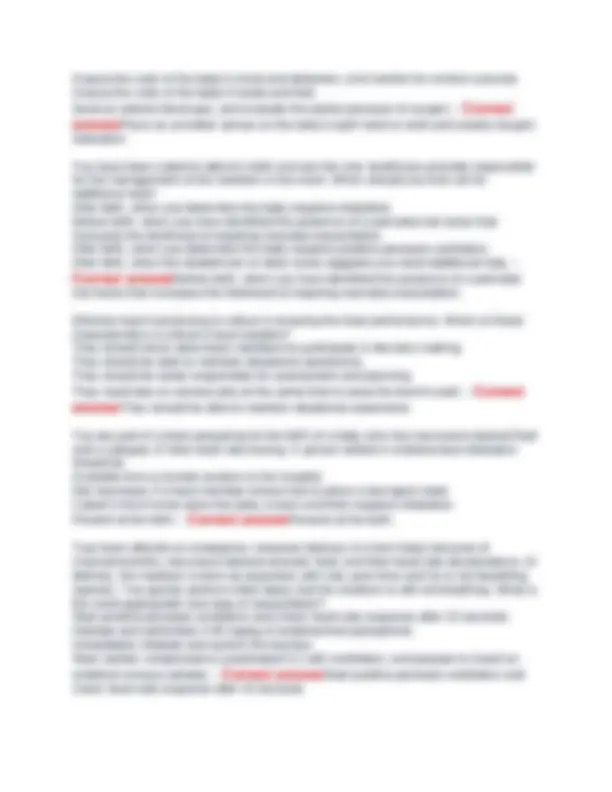
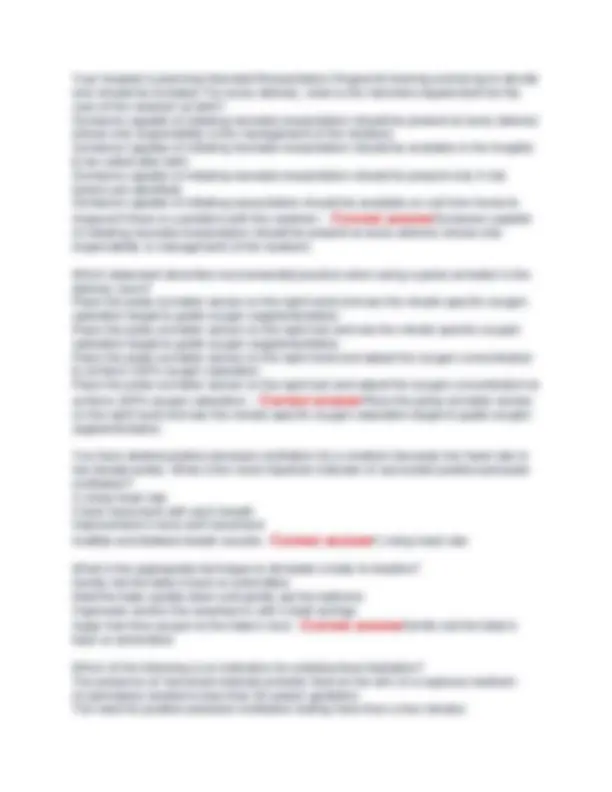
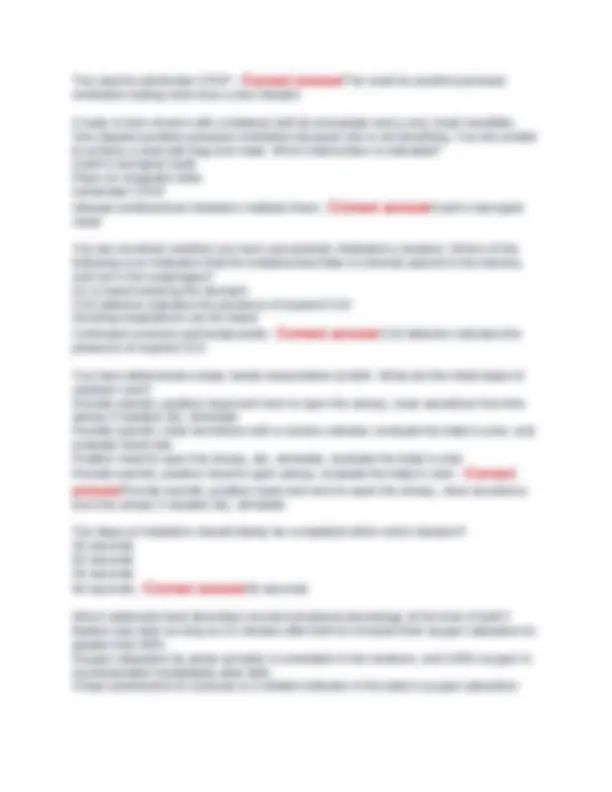
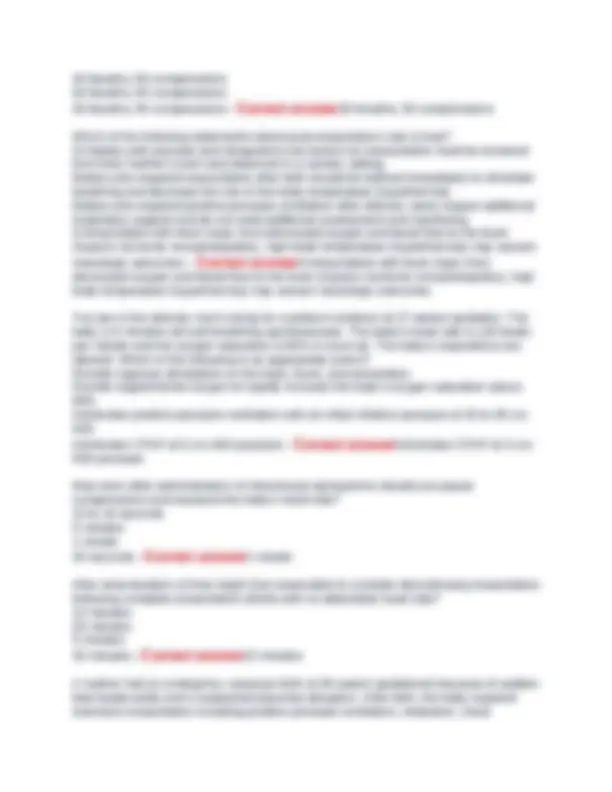
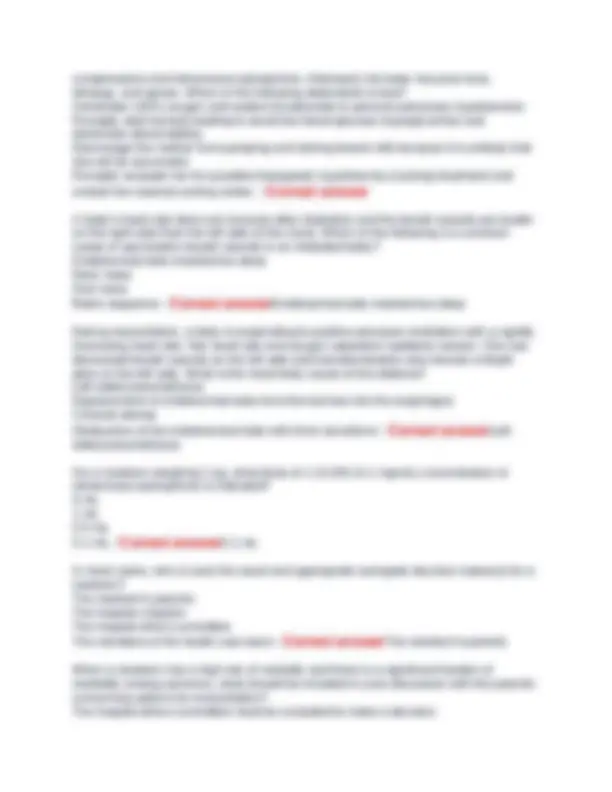
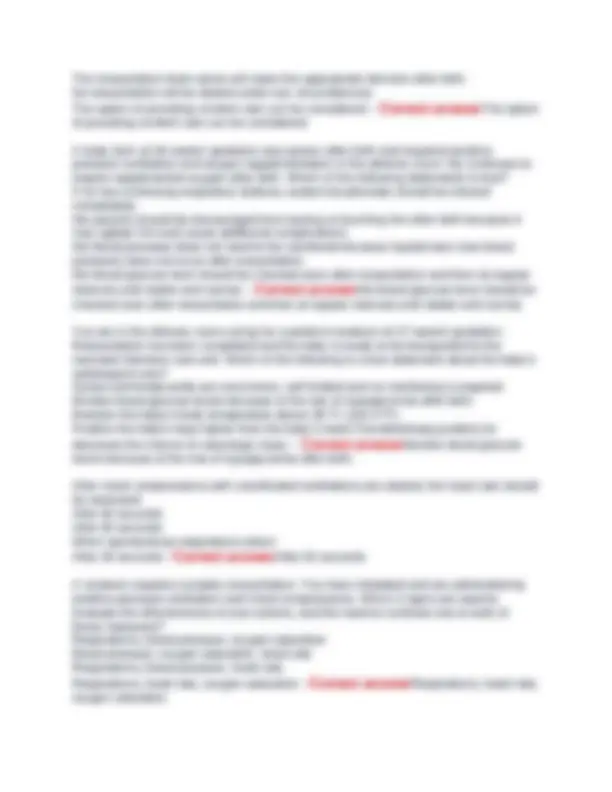


Study with the several resources on Docsity

Earn points by helping other students or get them with a premium plan


Prepare for your exams
Study with the several resources on Docsity

Earn points to download
Earn points by helping other students or get them with a premium plan
Community
Ask the community for help and clear up your study doubts
Discover the best universities in your country according to Docsity users
Free resources
Download our free guides on studying techniques, anxiety management strategies, and thesis advice from Docsity tutors
NRP 2024>50/50 Verified Questions With 100%Correct Answer.NRP 2024>50/50 Verified Questions With 100%Correct Answer.
Typology: Exams
1 / 11

This page cannot be seen from the preview
Don't miss anything!







After the initial steps of newborn care, a baby is apneic. What is the most important and effective action to take in the resuscitation of this baby? Provide positive-pressure ventilation. Perform chest compressions. Provide additional vigorous stimulation
ventilation. During the resuscitation of a newborn, you auscultate the apical pulse and count 10 beats over a 6 second period. What heart rate do you report to your team? 60 beats per minute 120 beats per minute 100 beats per minute
A newborn of 34 weeks' gestation is not breathing (apneic) at birth, does not respond to initial steps and requires positive-pressure ventilation. What concentration of oxygen should be used as you begin positive-pressure ventilation? 30 - 50% oxygen 100% oxygen 50 - 70% oxygen
You are at the resuscitation of a newborn who is gasping and has a heart rate of 60 beats per minute. What is the most important action you can take? Provide chest compressions Apply CPAP Provide positive-pressure ventilation
What is the most effective maneuver to establish spontaneous breathing in a baby that is apneic after initial steps? Continued rubbing of the back Administration of free-flow oxygen Administration of positive-pressure ventilation that inflates the lungs
that inflates the lungs Remembering MR. SOPA helps your team correct problems with ventilation. Which of the following steps are included in MR. SOPA?
Adjust Mask and Reposition head and neck; Suction mouth then nose and Open the mouth; increase Pressure; insert Alternative airway. Mouth opened, Reposition head, Saturation check, Obstruction check, Pulse oximeter sensor, Apply cardiac monitor leads. Ensure Mask seal, Repeat stimulation, Suction the airway, Oxygen regulation, Pulse oximeter sensor, Assess heart rate. Mouth opened, Repeat stimulation, Saturation check, Occlude pop-off valve, Perfusion
head and neck; Suction mouth then nose and Open the mouth; increase Pressure; insert Alternative airway A baby is born at 34 weeks' gestation. After the initial steps of resuscitation, the baby is not breathing (apneic). What are the next steps? Provide additional tactile stimulation, evaluate color and tone, evaluate heart rate. Administer free-flow oxygen, place a pulse oximeter sensor on the right hand or wrist, evaluate heart rate. Administer CPAP, place a pulse oximeter sensor on the right hand or wrist, evaluate color and tone. Initiative positive-pressure ventilation, place a pulse oximeter sensor on the right hand
place a pulse oximeter sensor on the right hand or wrist, evaluate heart rate. You are called to attend to a newborn at birth. At the time the baby is delivered, which 3 questions should you ask to evaluate whether the baby can stay with his mother or be moved to the radiant warmer for further assessment? Is the baby warm? Does the baby have good tone? Is the baby full-term? Is the amniotic fluid clear? Is the baby breathing or crying? Is the baby of low birth weight? Is the baby pink? Is the baby breathing or crying? Is the amniotic fluid clear? Is the baby term? Does the baby have good muscle tone? Is the baby breathing or
Is the baby breathing or crying? A full-term baby is born by emergency cesarean delivery because of fetal bradycardia (Category III fetal heart rate tracing). The baby is limp and not breathing after initial steps. What is the next step in the resuscitation process? Initiate positive-pressure ventilation and check for increasing heart rate Continue stimulating the baby for an additional 30 seconds Initiate chest compressions using the 2-thumb technique
positive-pressure ventilation and check for increasing heart rate. What is the recommended way to determine if a baby requires supplemental oxygen in the delivery room? Place an oximeter sensor on the baby's right hand or wrist and assess oxygen saturation.
Your hospital is planning Neonatal Resuscitation Program® training and trying to decide who should be included. For every delivery, what is the minimum requirement for the care of the newborn at birth? Someone capable of initiating neonatal resuscitation should be present at every delivery whose only responsibility is the management of the newborn. Someone capable of initiating neonatal resuscitation should be available in the hospital to be called after birth. Someone capable of initiating neonatal resuscitation should be present only if risk factors are identified. Someone capable of initiating resuscitation should be available on call from home to
of initiating neonatal resuscitation should be present at every delivery whose only responsibility is management of the newborn. Which statement describes recommended practice when using a pulse oximeter in the delivery room? Place the pulse oximeter sensor on the right hand and use the minute specific oxygen saturation target to guide oxygen supplementation. Place the pulse oximeter sensor on the right foot and use the minute specific oxygen saturation target to guide oxygen supplementation. Place the pulse oximeter sensor on the right hand and adjust the oxygen concentration to achieve 100% oxygen saturation. Place the pulse oximeter sensor on the right foot and adjust the oxygen concentration to
on the right hand and use the minute specific oxygen saturation target to guide oxygen supplementation. You have started positive-pressure ventilation for a newborn because her heart rate is low (bradycardia). What is the most important indicator of successful positive-pressure ventilation? A rising heart rate Chest movement with each breath Improvement in tone and movement
What is the appropriate technique to stimulate a baby to breathe? Gently rub the baby's back or extremities Hold the baby upside down and gently pat the buttocks Vigorously suction the oropharynx with a bulb syringe
back or extremities Which of the following is an indication for endotracheal intubation? The presence of meconium-stained amniotic fluid on the skin of a vigorous newborn All premature newborns less than 30 weeks' gestation The need for positive-pressure ventilation lasting more than a few minutes
ventilation lasting more than a few minutes A baby is born at term with a bilateral cleft lip and palate and a very small mandible. She requires positive-pressure ventilation because she is not breathing. You are unable to achieve a seal with bag and mask. Which intervention is indicated? Insert a laryngeal mask Place an orogastric tube Administer CPAP
mask You are uncertain whether you have successfully intubated a newborn. Which of the following is an indication that the endotracheal tube is correctly placed in the trachea, and not in the esophagus? Air is heard entering the stomach CO2 detector indicates the presence of expired CO Grunting respirations can be heard
presence of expired CO You have determined a baby needs resuscitation at birth. What are the initial steps of newborn care? Provide warmth, position head and neck to open the airway, clear secretions from the airway if needed, dry, stimulate Provide warmth, clear secretions with a suction catheter, evaluate the baby's color, and evaluate heart rate Position head to open the airway, dry, stimulate, evaluate the baby's color
from the airway if needed, dry, stimulate The steps of intubation should ideally be completed within which duration? 30 seconds 60 seconds 40 seconds
Which statement best describes normal transitional physiology at the time of birth? Babies may take as long as 10 minutes after birth to increase their oxygen saturation to greater than 90%. Oxygen saturation by pulse oximetry is unreliable in the newborn, and 100% oxygen is recommended immediately after birth. Visual assessment of cyanosis is a reliable indicator of the baby's oxygen saturation.
What is the preferred method for assessing heart rate during chest compressions? Electronic cardiac (ECG) monitoring Palpate the umbilical cord Pulse oximeter reading on the right hand or wrist
What is the ideal depth of chest compressions for a newborn? One-fourth of the anterior-posterior diameter of the chest One-third of the anterior-posterior diameter of the chest Half of the anterior-posterior diameter of the chest
of the anterior-posterior diameter of the chest What time frame should be used to administer intravenous epinephrine? Rapid push, as quickly as possible Over 5 to 10 minutes Over 1 to 2 minutes
Which of the following is the best indication for volume expansion after resuscitative efforts that included intubation, chest compressions, and IV epinephrine? The baby's heart rate remains 50 beats per minute after resuscitative efforts and pulses are weak. The baby's heart rate is 120 beats per minute after resuscitative efforts, but she is very pale. The baby's heart rate is 120 beats per minute after resuscitative efforts and there is a history of extensive vaginal bleeding during labor. The baby's heart rate rapidly increased to 120 beats per minute with epinephrine, but
minute after resuscitative efforts and pulses are weak. Which statement best describes the ethical principle(s) that guide the resuscitation of a newborn? The ethical principles of beneficence, non-maleficence, autonomy, and justice are used for adults and older children, but they do not apply to newborns. The baby is a minor and all decisions regarding resuscitation should be made during an emergency meeting of the hospital ethics committee. The approach to decisions in the newborn should be guided by the same principles used for adults and older children. All decisions regarding resuscitation are made by the health care providers, and parents
the newborn should be guided by the same principles used for adults and older children When coordinating positive-pressure ventilation with chest compressions, how many events are performed each minute? 60 breaths, 120 compressions
40 breaths, 80 compressions 60 breaths, 60 compressions
Which of the following statements about post-resuscitation care is true? All babies with prenatal and intrapartum risk factors for resuscitation must be removed from their mother's room and observed in a nursery setting. Babies who required resuscitation after birth should be bathed immediately to stimulate breathing and decrease the risk of low body temperature (hypothermia). Babies who required positive-pressure ventilation after delivery rarely require additional respiratory support and do not need additional assessment and monitoring. Among babies with brain injury from decreased oxygen and blood flow to the brain (hypoxic-ischemic encephalopathy), high body temperature (hyperthermia) may worsen
decreased oxygen and blood flow to the brain (hypoxic-ischemic encephalopathy), high body temperature (hyperthermia) may worsen neurologic outcomes. You are in the delivery room caring for a preterm newborn at 27 weeks' gestation. The baby is 5 minutes old and breathing spontaneously. The baby's heart rate is 120 beats per minute and the oxygen saturation is 90% in room air. The baby's respirations are labored. Which of the following is an appropriate action? Provide vigorous stimulation on the back, trunk, and extremities Provide supplemental oxygen to rapidly increase the baby's oxygen saturation above 95% Administer positive-pressure ventilation with an initial inflation pressure of 30 to 35 cm H
H20 pressure How soon after administration of intravenous epinephrine should you pause compressions and reassess the baby's heart rate? 10 to 16 seconds 5 minutes 1 minute
After what duration of time might it be reasonable to consider discontinuing resuscitation following complete resuscitation efforts with no detectable heart rate? 10 minutes 20 minutes 5 minutes
A mother had an emergency cesarean birth at 39 weeks' gestational because of sudden fetal bradycardia and a suspected placental abruption. After birth, the baby required extensive resuscitation including positive pressure ventilation, intubation, chest
The resuscitation team alone will make the appropriate decision after birth. No resuscitation will be started under any circumstances.
of providing comfort care can be considered. A baby born at 36 weeks' gestation was apneic after birth and required positive- pressure ventilation and oxygen supplementation in the delivery room. He continues to require supplemental oxygen after birth. Which of the following statements is true? If he has continuing respiratory distress, sodium bicarbonate should be infused immediately. His parents should be discouraged from seeing or touching him after birth because it may agitate him and cause additional complications. His blood pressure does not need to be monitored because hypotension (low blood pressure) does not occur after resuscitation. His blood glucose level should be checked soon after resuscitation and then at regular
checked soon after resuscitation and then at regular intervals until stable and normal. You are in the delivery room caring for a preterm newborn at 27 weeks' gestation. Resuscitation has been completed and the baby is ready to be transported to the neonatal intensive care unit. Which of the following is a true statement about the baby's subsequent care? Apnea and bradycardia are uncommon, self-limited and no monitoring is required. Monitor blood glucose levels because of the risk of hypoglycemia after birth. Maintain the baby's body temperature above 38 ºC (100.4 ºF). Position the baby's legs higher than the baby's head (Trendelenburg position) to
levels because of the risk of hypoglycemia after birth. After chest compressions with coordinated ventilations are started, the heart rate should be assessed: After 60 seconds After 90 seconds When spontaneous respirations return
A newborn requires complex resuscitation. You have intubated and are administering positive-pressure ventilation and chest compressions. Which 3 signs are used to evaluate the effectiveness of your actions, and the need to continue one or both of these measures? Respirations, blood pressure, oxygen saturation Blood pressure, oxygen saturation, heart rate Respirations, blood pressure, heart rate
oxygen saturation
A woman is admitted at 24 weeks' gestation with rupture of membranes, maternal fever, and premature labor. The care team offers the parents counseling. What is likely to be helpful? Assure parents that you can accurately determine the baby's prognosis immediately after birth. Wait to speak with mother until she has received a sedative to relieve her anxiety. The obstetric provider and neonatologist should meet separately with the parents because of their different perspectives. Provide parents with accurate prognostic information using all relevant information
prognostic information using all relevant information affecting their baby's prognosis. Which of the following is true about the preparation and resources needed for a very preterm birth? The delivery room temperature should be decreased to approximately 65ºF to 66ºF (18.3ºC to 18.8ºC). A size-1 laryngoscope and size 3.5-mm endotracheal tube should be prepared for the initial intubation attempt. Personnel skilled in intubation and umbilical catheter placement may be on call at home. Prepare the preheated radiant warmer with a thermal mattress, plastic wrap or bag, and
mattress, plastic wrap or bag, and a hat.